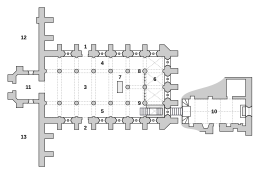
Back Roslin kapellası Azerbaijani Рослински параклис Bulgarian Capella Rosslyn Catalan Rosslyn-Kapelle German Capilla Rosslyn Spanish Rosslyn kapera Basque نمازخانه راسلین Persian Rosslynin kappeli Finnish Chapelle de Rosslyn French Capela de Rosslyn Galician
| Rosslyn Chapel | |
|---|---|
 Rosslyn Chapel, August 2014 | |
| 55°51′19″N 3°09′37″W / 55.85528°N 3.16028°W | |
| OS grid reference | NT275630 |
| Location | Roslin, Midlothian |
| Country | Scotland |
| Denomination | Scottish Episcopal Church |
| Previous denomination | Catholic Church |
| Website | www |
| History | |
| Status | Chapel |
| Dedication | Saint Matthew |
| Architecture | |
| Functional status | Active |
| Heritage designation | Category A |
| Groundbreaking | 20 September 1456 |
| Administration | |
| Diocese | Edinburgh |
| Clergy | |
| Priest in charge | The Revd Dr Joe Roulston |
Listed Building – Category A | |
| Official name | Rosslyn Chapel (Episcopal), formerly Collegiate Church of St Matthew, including vaults, burial ground and boundary hills |
| Designated | 22 January 1971 |
| Reference no. | 13028[1] |
Rosslyn Chapel, formerly known as the Collegiate Chapel of Saint Matthew, is a 15th-century Episcopal chapel located in the village of Roslin in Midlothian, Scotland.

- North entrance
- South entrance
- Choir
- North aisle
- South aisle
- Lady chapel
- Altar
- Master pillar
- Apprentice pillar
- Sacristy
- Baptistery
- North transept
- South transept
The chapel is dedicated to Saint Matthew the Evangelist and was founded on a small hill above Roslin Glen as a collegiate church (with between four and six ordained canons and two boy choristers) in the mid-15th century. The chapel was founded by William Sinclair, 1st Earl of Caithness of the Scoto-Norman Sinclair family. Rosslyn Chapel is the third Sinclair place of worship at Roslin, the first being in Roslin Castle and the second (whose crumbling buttresses can still be seen today) in what is now Roslin Cemetery.[2]
Sinclair founded the college to celebrate the Liturgy of the Hours throughout the day and night, and also to celebrate Catholic Masses for all the faithful departed, including the deceased members of the Sinclair family. During this period, the rich heritage of plainsong (a single melodic line) or polyphony (vocal harmony) were used to enrich the singing of the liturgy. Sinclair provided an endowment to pay for the support of the priests and choristers in perpetuity. The priests also had parochial responsibilities.
After the Scottish Reformation (1560), Catholic worship in the chapel was brought to an end. The Sinclair family continued to be Catholics until the early 18th century.
From the early 1700s to 1861, the chapel was closed to public worship. It was then reopened as a place of worship according to the rites of the Scottish Episcopal Church, a member church of the Anglican Communion. The chapel was the target of a bombing in 1914 during the suffragette bombing and arson campaign.
Since the late 1980s, the chapel has been the subject of speculative theories concerning a connection with the Knights Templar and the Holy Grail, and Freemasonry. It was prominently featured in this role in Dan Brown's bestselling novel The Da Vinci Code (2003) and its 2006 film adaptation. Medieval historians say these accounts have no basis in fact. Rosslyn Chapel remains privately owned. The current owner is Peter St Clair-Erskine, 7th Earl of Rosslyn.[3]

- ^ Historic Environment Scotland. "Rosslyn Chapel (LB13028)". Retrieved 30 November 2016.
- ^ Turnbull, Michael, 'Rosslyn Chapel Revealed' (Sutton Publishing Ltd., November 2007) ISBN 0-7509-4467-6 ISBN 978-0750944670
- ^ "About Rosslyn Chapel". RosslynChapel.org.uk. Retrieved 5 November 2014.
© MMXXIII Rich X Search. We shall prevail. All rights reserved. Rich X Search
